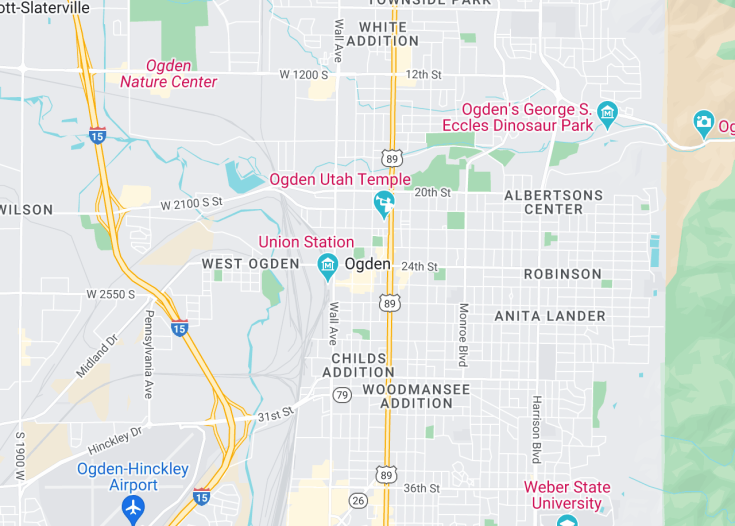Ogden, Utah, nestled amidst the stunning Wasatch Mountain Range, boasts a unique blend of vibrant history, contemporary culture, and breathtaking natural landscapes. Known for its historic railroads and as a gateway to diverse outdoor activities, Ogden offers year-round entertainment from skiing in world-class resorts to exploring eclectic museums and enjoying local gastronomy.
For a memorable Ogden experience, visit the historic 25th Street for unique boutiques, galleries, and restaurants that capture the city’s spirited essence.
Don’t miss the opportunity to hike the scenic Waterfall Canyon Trail, offering panoramic views and a stunning 200-foot waterfall as the reward.
Top things to do & see in Ogden
Select the following sights and activities to discover best tickets and tours available in Ogden.
Ogden: Gateway to Adventure
| Country | Utah (USA) |
| Time in Ogden | GMT-6 |
| Language spoken | English |
| Population | 87,321 (US Census Bureau, 2020) |
| Currency | United States Dollar (USD $) |
| Airports | Ogden-Hinckley Airport (3 mi / 4.8 km)
|
Ogden, Utah, is a vibrant city nestled at the foot of the majestic Wasatch Range. Known for its historical significance, it was a major railway hub in the past and played a pivotal role in developing the American West. Ogden offers a perfect blend of outdoor adventures, historic architecture, and a thriving arts scene. Its history dates back to 1846 when it was first established by Mormon settlers. Now, it’s a modern sanctuary for activities such as hiking, skiing, and kayaking, thanks to its proximity to several world-class ski resorts and scenic natural parks like Antelope Island State Park.
Where is Ogden?
Ogden is located in northern Utah, nestled against the east side of the Wasatch Mountain Range.
Distances:
| Route | Distance by car | Time by car |
|---|---|---|
| Salt Lake City to Ogden | 39 miles | 40 minutes |
| Provo to Ogden | 80 miles | 1 hour 15 minutes |
What is Ogden famous for?
Ogden is famous for its rich history as a major railroad hub and its vibrant outdoor culture, hosting numerous hiking trails and being close to several ski resorts.
History
Pre-1850: Indigenous Foundations
The area now known as Ogden, Utah, was originally inhabited by the Shoshone, Ute, and Goshute tribes. These indigenous communities enjoyed the rich, diverse environment of the Weber Valley for thousands of years prior to European settlement, relying on its abundant resources for hunting, fishing, and gathering.
1850-1900: Settlement and Growth
In 1846, Miles Goodyear established what would later become Ogden as Fort Buenaventura. Just two years later, the area was purchased by Mormon settlers from the Church of Jesus Christ of Latter-day Saints, led by Brigham Young. The town was renamed Ogden in honor of Peter Skene Ogden, a trapper for the Hudson’s Bay Company. The arrival of the Transcontinental Railroad in 1869 transformed Ogden into a major trade hub, fostering a diverse population and dynamic economy.
1900-1950: Industrial Expansion
In the early 20th century, Ogden continued to prosper as a key railroad and industrial city. The establishment of the Ogden Union Stockyard in 1917 further boosted the local economy. During World War II, the city’s strategic location and railroad connections made it an essential military site, significantly impacting local development and demographic changes.
1950-Present: Diversification and Revitalization
Post-war economic shifts led to a decline in rail and industrial dominance, prompting Ogden to diversify its economic base towards commerce and recreation, especially with its proximity to several ski resorts and national forests. Recent decades have seen significant revitalization efforts in the historic downtown area, transforming Ogden into a vibrant community with a focus on outdoor activities and heritage tourism.
Visit Ogden
What to see and do in Ogden, Utah (USA)
Explore the scenic beauty and cultural attractions Ogden has to offer. Visit the historic 25th Street with its vibrant array of shops, galleries, and restaurants. Discover the Union Station, housing museums like the Utah State Railroad Museum and the Browning Firearms Museum. Outdoor enthusiasts can enjoy the Ogden River Parkway and the nearby Wasatch Mountains for hiking, skiing, and mountain biking. Don’t miss the George S. Eccles Dinosaur Park for a fascinating journey through prehistoric times.
- Historic 25th Street for shopping and dining
- Union Station and its museums
- Ogden River Parkway for scenic walks
- Wasatch Mountains for outdoor activities
- George S. Eccles Dinosaur Park
Signature Events in Ogden
Ogden’s calendar is dotted with vibrant events. The Ogden Music Festival in June brings together music enthusiasts for a weekend of folk, blues, and rock performances. The annual Ogden Marathon in May offers breathtaking views along the course. Winter months are brightened by the Christmas Village, creating a festive atmosphere with lights, displays, and a visit from Santa Claus.
Best time to visit Ogden
The ideal time to visit Ogden depends on your interests. Winter sports enthusiasts should plan a trip from December to March to take advantage of the excellent skiing conditions. Those interested in hiking and outdoor festivals will find spring through fall ideal, particularly from May to September, when the weather is pleasant and the city’s cultural events are in full swing.
Is Ogden worth visiting?
Ogden, Utah, presents a compelling destination with its rich historical heritage and stunning natural surroundings. The city offers a mix of cultural and recreational activities that cater to both history buffs and outdoor adventurers. Although some areas are still under development, the revitalized downtown and convenient access to natural attractions make Ogden a worthwhile visit for those seeking a blend of urban and outdoor experiences. However, visitors looking for a more bustling urban atmosphere might find it quieter than larger cities.









